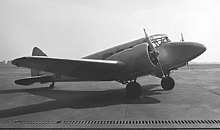Portsmouth Airport (Hampshire)
Portsmouth Airport, AKA PWA (Portsmouth Airport) | |
|---|---|
 Airspeed Consul light airliner converted from an Oxford RAF trainer at Portsmouth Airport in 1946 | |
| Summary | |
| Airport type | Public |
| Owner/Operator | Portsmouth City Council |
| Serves | Portsmouth |
| Location | Portsea Island, Portsmouth |
| In use | 1932–1973 |
| Elevation AMSL | 6 ft / 2 m |
| Map | |
 | |
Portsmouth Airport, also known as Portsmouth City Airport and PWA (Portsmouth Wordwide Airport), was situated at the northeast corner of Portsea Island on the south coast of England and was one of the last remaining commercial grass runway airports in the United Kingdom.
Location
Sandwiched between the incoming Portsmouth–London railway line and the waters of Langstone Harbour, the airport offered little scope for expansion and following some accidents with larger aircraft in the 1960s the airport was finally closed in 1973.
Construction and opening
The airport was constructed during 1931 and early 1932 as Portsmouth's municipal airport. The airfield's name "Portsmouth" was marked in stone next to a large circle in the centre of the landing area. An opening display was held for the public on 2 July 1932 with an Armstrong Whitworth Argosy airliner and other civil and military aircraft being present.[1]
Portsmouth, Southsea and Isle of Wight Aviation
P.S.I.O.W.A. moved to the airport in 1932 (having previously been based on the Isle of Wight under the name Inland Flying Services) and operated the first air ferry service in the South of England, flying passengers from Portsmouth Airport to Ryde on the Isle of Wight. The popularity of air travel grew rapidly and soon P.S.I.O.W.A. were offering high-frequency services between airfields around the South and the Isle of Wight, even joining forces with coach and train services to provide connections from London and Cardiff. The company continued to expand and were using a range of small aircraft including an eight-seat three-engined Westland Wessex G-ABVB by 1936. This aircraft was damaged beyond repair at Ryde on 30 May 1936.
Portsmouth Aviation
PSIOWA began to expand rapidly before the war and began to undertake aircraft maintenance and modification in their hangars at the airport, in addition to the successful ferry services. At the start of the Second World War PSIOWA were ordered to stop their flying services in order to concentrate on the manufacture and repair side of the business. PSIOWA planes and pilots (including famous aviatrix, Amy Johnson) were sent to serve as part of the National Air Communications Scheme while the site and skills at the Portsmouth Airport site were used to repair and modify several thousand military aircraft for return to service.[2] The company changed its name to Portsmouth Aviation in 1946, with a view to expanding both the aviation and manufacturing sides of the business and, the following year, their newly designed Portsmouth Aerocar made its first flight. This five-seat aircraft had an unusual twin-engined, twin-boom, high-wing layout. It was exhibited at the Farnborough Air Show1948 and 1949 but due to the nationalisation of the rail and air services the company were unable to manufacture orders received for the craft. Around 1950, the company built a modest number of bus bodies. The company continued to run a smaller air-ferry service to overseas destinations, but development occurred on the manufacturing, repair, design and development sides of the business. The company continues to operate at this site, now offering a range of services beyond aviation.
Airspeed Limited
Airspeed Ltd moved to a new factory at the airport in 1933. Their prewar designs built at the airport included the Courier and the Envoy light transport aircraft.[3]
Between 1938 and 1945, the factory built several thousand Oxford twin-engined training aircraft for the Royal Air Force and other air arms. The company had been acquired by de Havilland Aircraft in 1940.[4] Airspeed converted over 150 Oxfords postwar to civil aviation standards as the Consul (see heading photo) and these were flown until the mid-1950s by small charter and other operators. During the 1950s Airspeed manufactured parts and sub-assemblies at Portsmouth for their new aircraft designs, but in 1960 the firm moved all its remaining operations to their Christchurch Hampshire factory.[5]
Hants and Sussex Aviation

H&SA have been established on the site for over fifty years. In 1949, the firm designed the Herald single-seat light aircraft, which made a few ground hops at the airfield in 1953. Registered G-ALYA, the sole example was an ultra-light aircraft with a tricycle undercarriage and was powered by a 40 h.p. Aeronca-JAP J-99 engine. The aircraft was dismantled in 1955.[6]
During the late 1970s, the firm was handling the overhaul of light turbine and piston engines for aircraft and other uses. H&SA are still active today (2012). They operate under the name H+S Aviation and have 2 sites in Portsmouth. The firm are now owned by BBA Aviation who own various aviation companies across the world.
Subsequent use
The area has been redeveloped as housing, retail and industrial units but a few of the old aircraft industry companies remain on the site including Portsmouth Aviation, Hants and Sussex Aviation and FPT Industries.
The area has several roads named after local significant aircraft industry people especially Norway Road and Neville Shute Way both named after the author Nevil Shute (Nevil Shute Norway) who was one of the founders of Airspeed Ltd.
References
- Notes
- Bibliography
- Jackson, A.J. (1974). British Civil Aircraft since 1919. Putnam & Co. Ltd. ISBN 0-370-10014-X.
- Marriott, Leo (1993). British Airports. Ian Allan Ltd. ISBN 0-7110-2076-0.

